M.I.A: A MANTUA CA. 1720
The Museum of Industrial Arts in Oslo have in their care a rather splendid early style mantua. A mantua was a female attire of the late 17th and early 18th century. It consisted of three main parts - an overdress open in front, an underskirt of the same or contrasting fabric, and an ornamental stomacher. The overdress was fastened to the stomacher. Often these dresses had a train which would be draped over the back.
The one in Oslo is from the 1720s. It originates from Bergen in Western Norway, which was a rich shipping city. It is believed to have been a wedding dress.
The fabric is a green silk with silver/white pattern accented with red/copper and yellow/gold, and is probably French. The pattern of the fabric originates from ca. 1690, but stayed in vogue for some decades. Also, often fine fabrics were purchased and saved until the right occasion came along, to be used for wedding clothes, or given away as fine presents.
The stomacher and front dress has decorations of metal bobbin lace, and tabs in the bottom. Similar metal bobbin lace is used around the neck opening, ending in a small V in the back.
The train is long and square, and has probably been pinned up in elaborate ways to form a backdrape and/or sidedrape - probably not too unlike one at V&A in London (picture 1). The back of the sleeves are pleated, as are the cuffs. Similar pleated cuffs can be seen in the Danish Valdemar Slot mantua from Nationalmuseet in Copenhagen (picture 2):
SIMILAR DRESSES
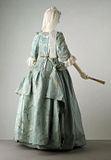
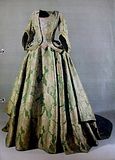
PICTURES
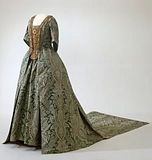
Picture taken from http://harriet.nasjonalmuseet.no/draktgallerier/kjole-3/

Front shot. I'm guessing the overdress would have some sort of side/back drapes when worn in the 18th century, like the V&A version with similar square train. But it looks very nice as it is too.
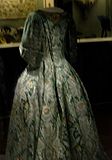
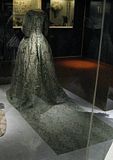
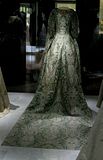
Backshots. The pattern of the fabric is nicely displayed in the pleats in the back, and wonderfully symmetrical.
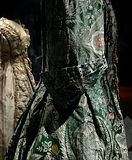
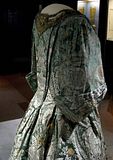
Pictures from the side, showing the sleeve and cuff. Originally a chemise would have been worn underneath, whose elbow-length, lace decorated sleeves would poke out from the dress sleeves.
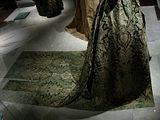
Picture from the side, showing the train.
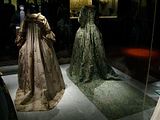
Picture from the back, showing the mantua and the Robe a la Française side by side. Here you can see how the tucked-down pleats of the mantua eventually evolved into the floating backpleats of the Robe a la Française. There is a noticeable height difference between the dresses on display. The Robe is tiny, while the Mantua appears rather average-sized. It looked to me like the woman wearing the Mantua must have been almost a head higher than the Robe wearer.
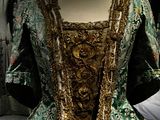
The metallic bobbin-lace decorated stomacher. So beautiful! The foundations seems to be a metallic weave, with a looped pattern in front, with a base of a thicker woven metallic "fabric, and metallic bobbin lace around it. The loop "fans" on top are especially gorgeous.
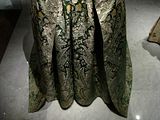
Front skirts, showing the fabric and pattern well. It was nice to see how incredibly symmetrical this dress was. Dresses from the 17th and 18th century are always balanced, but not always symmetrical. It can be that the fabric is not symmetrical, or that they've cut it as fabric-saving as possible. And to be honest, I dig that. It always gives me a feeling of it being authentic. But this one appeared to be symmetrical down to the smallest details. Interesting to see.